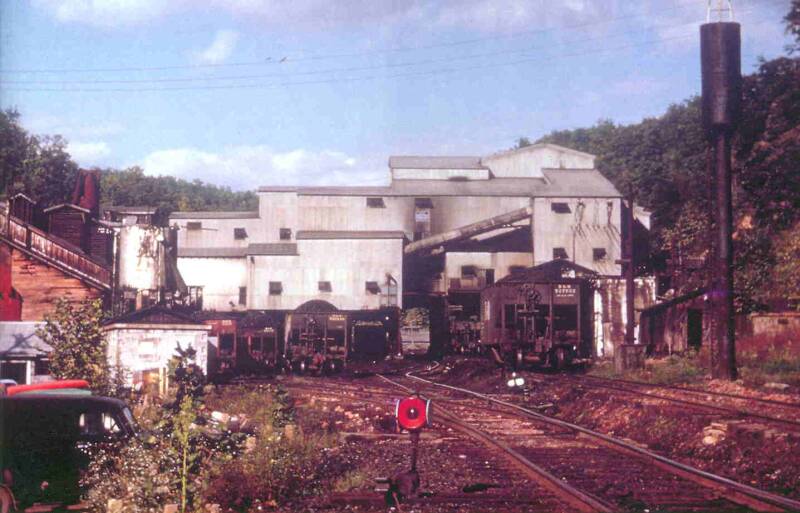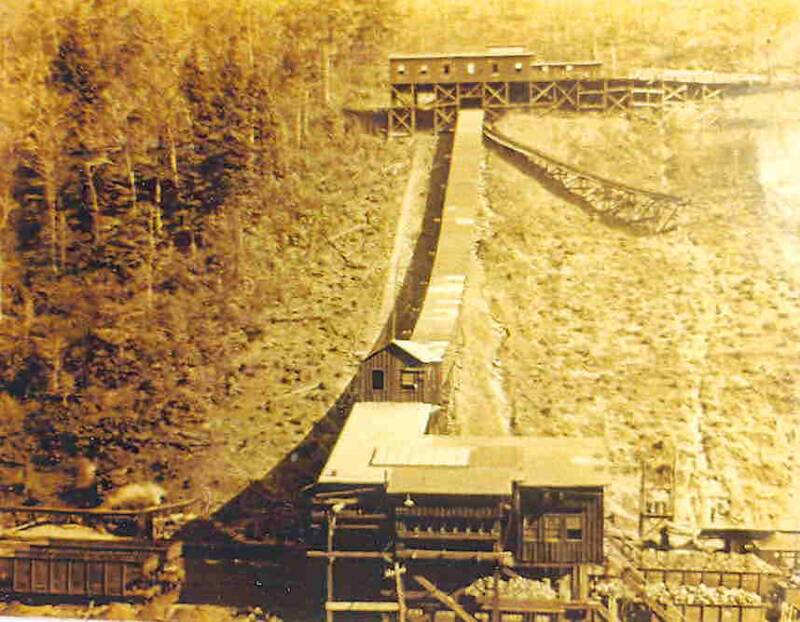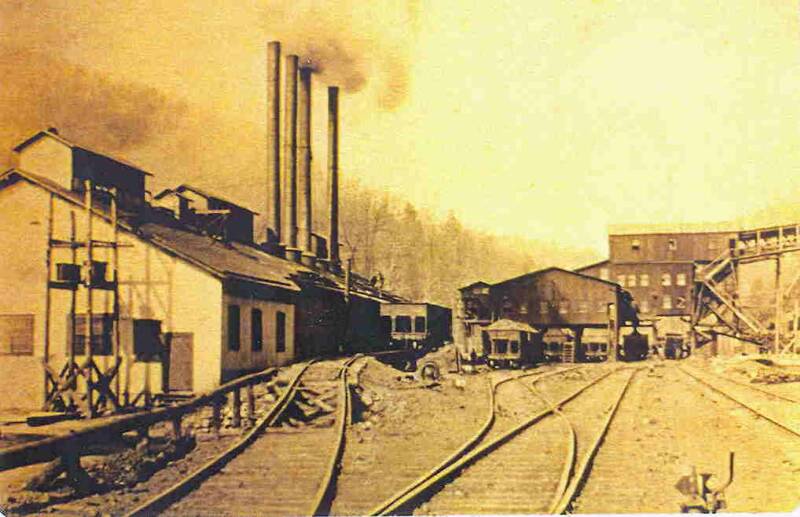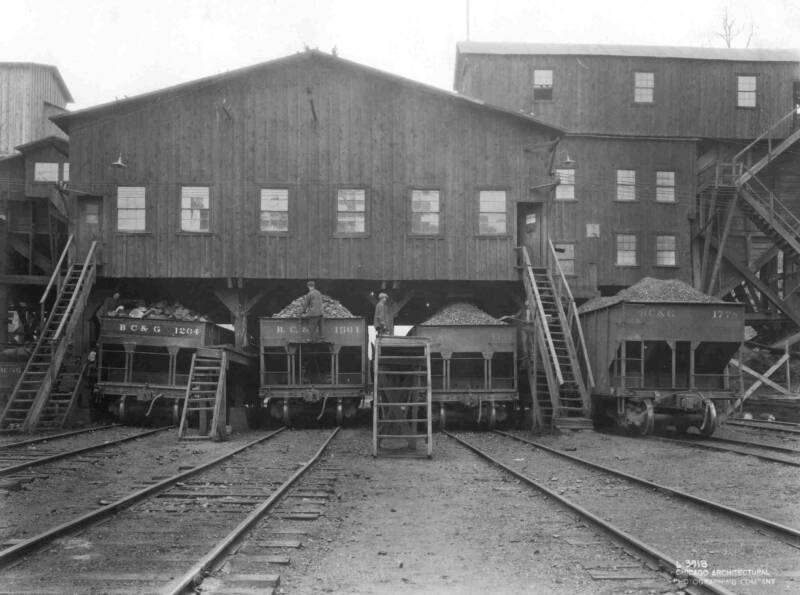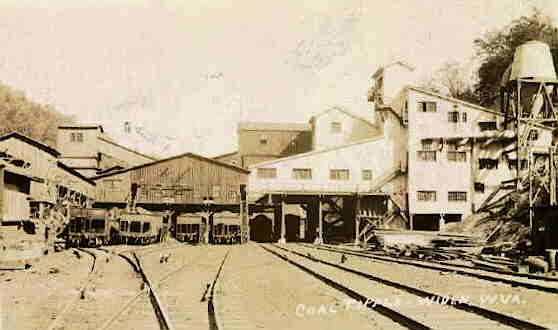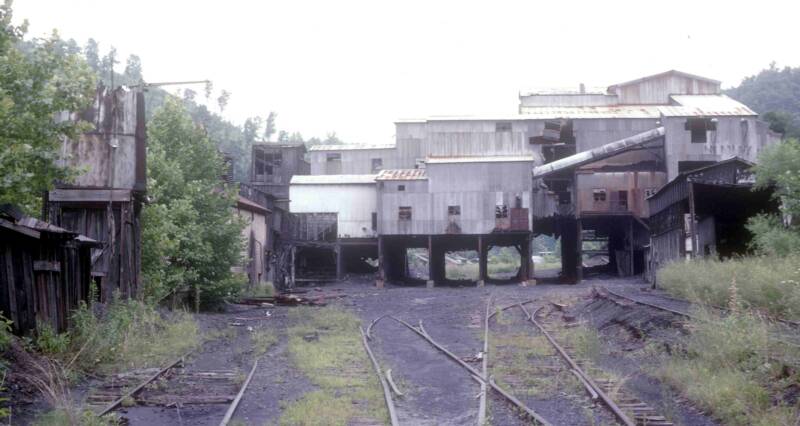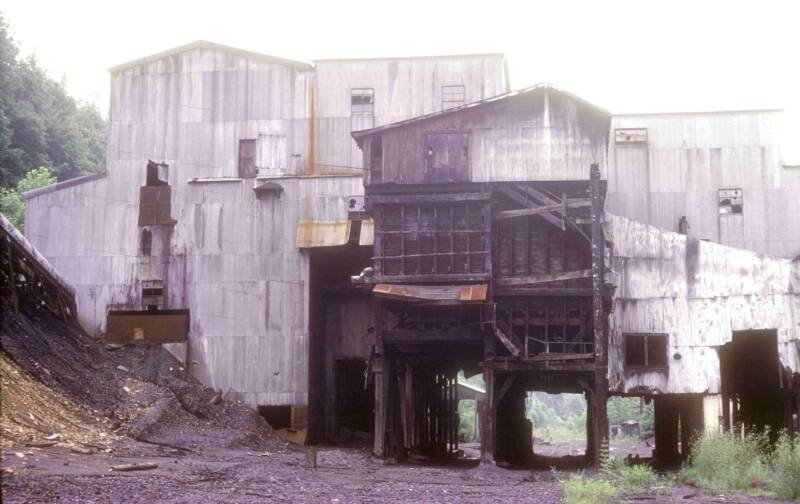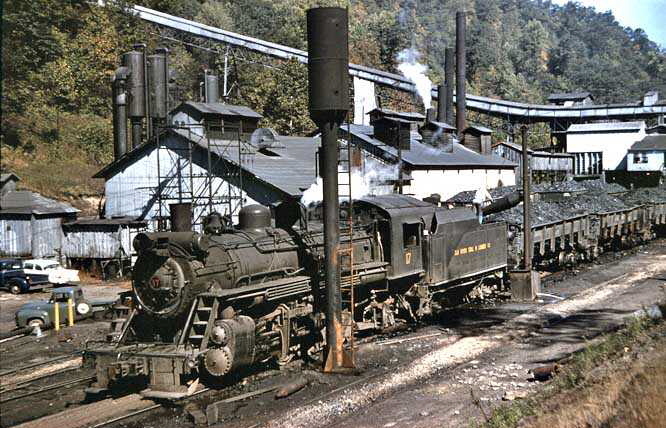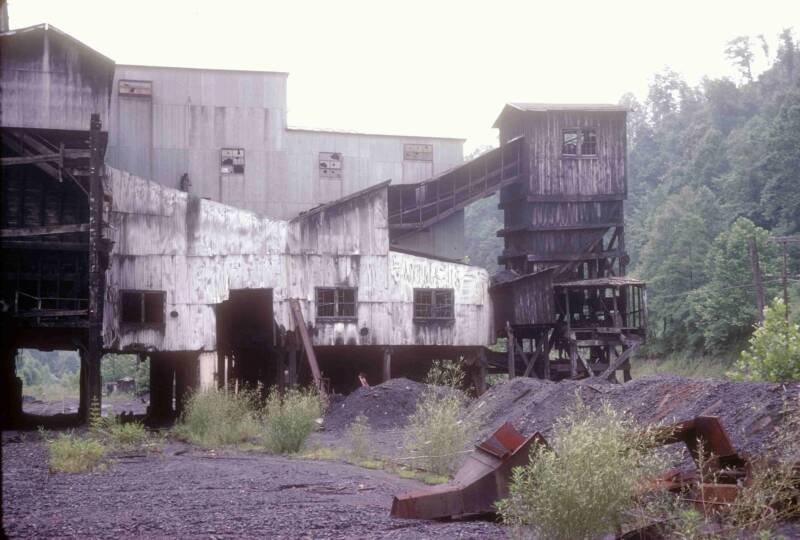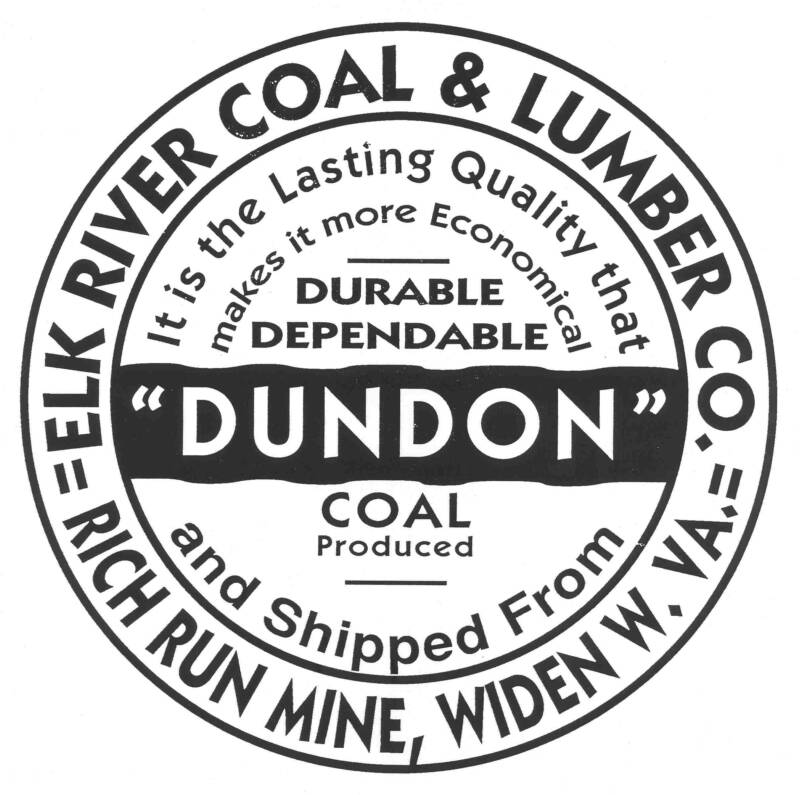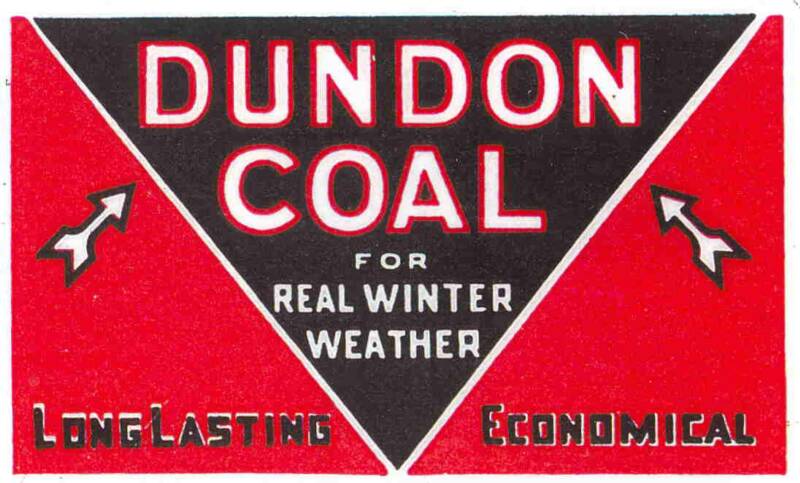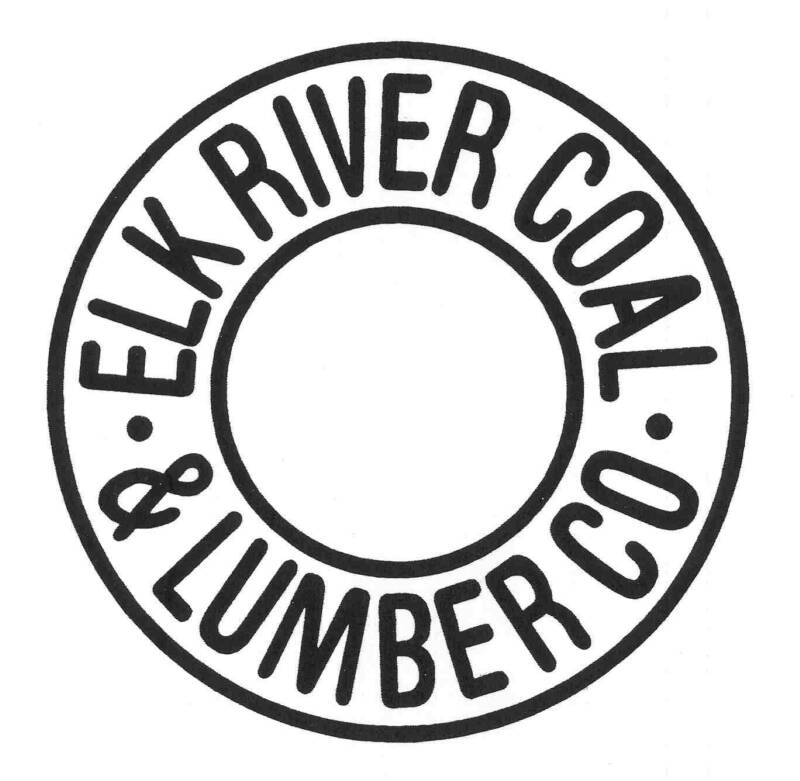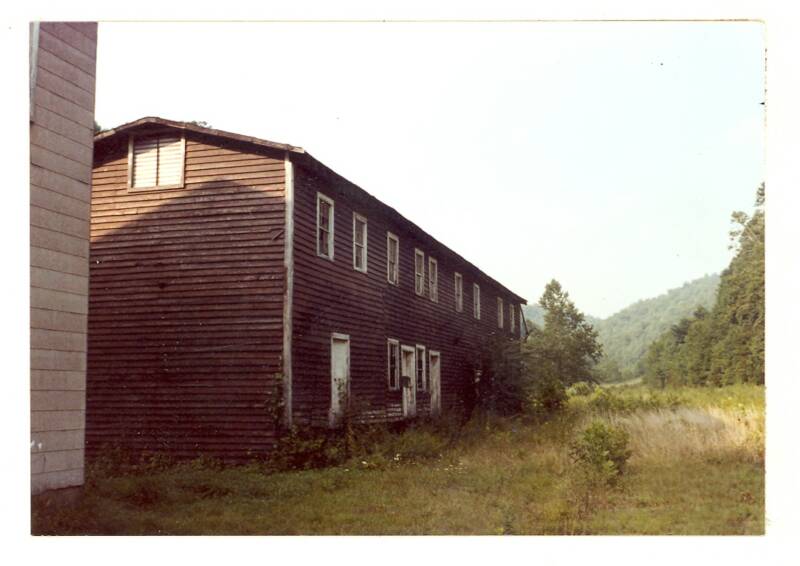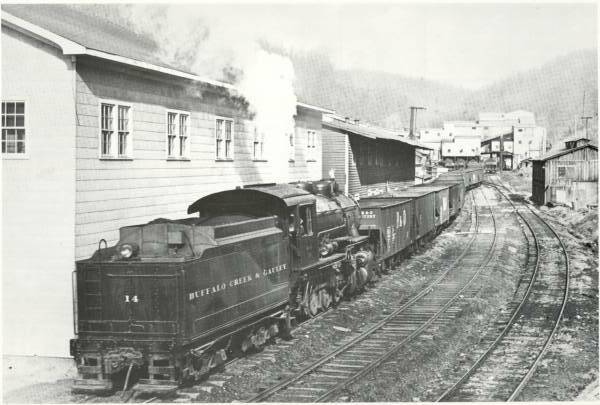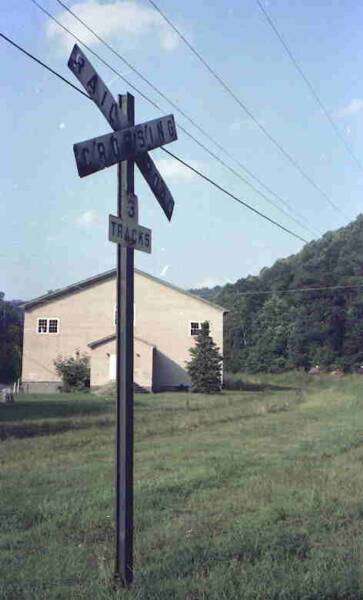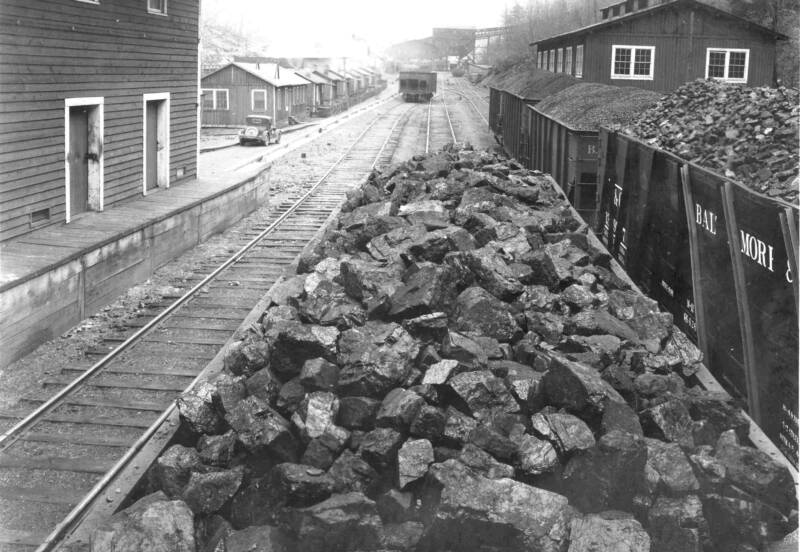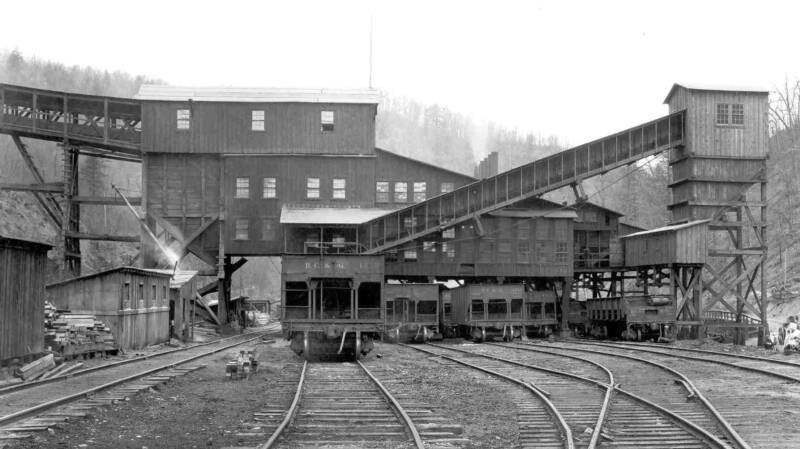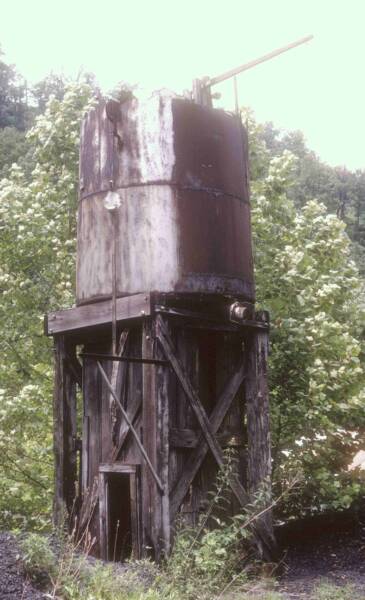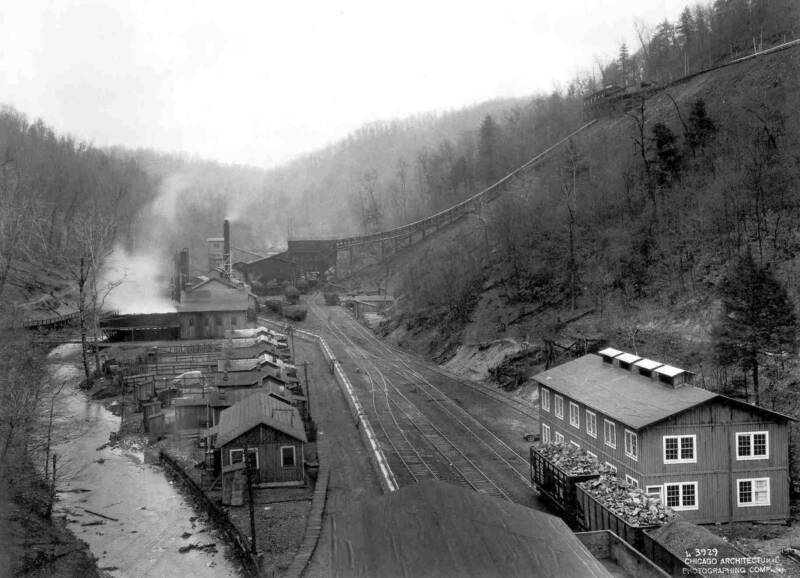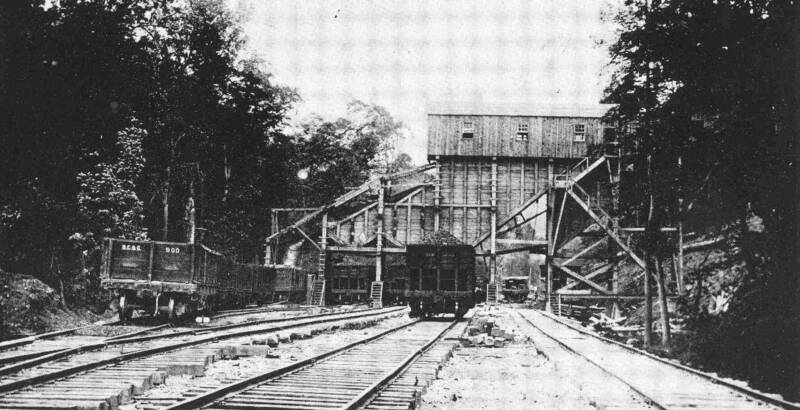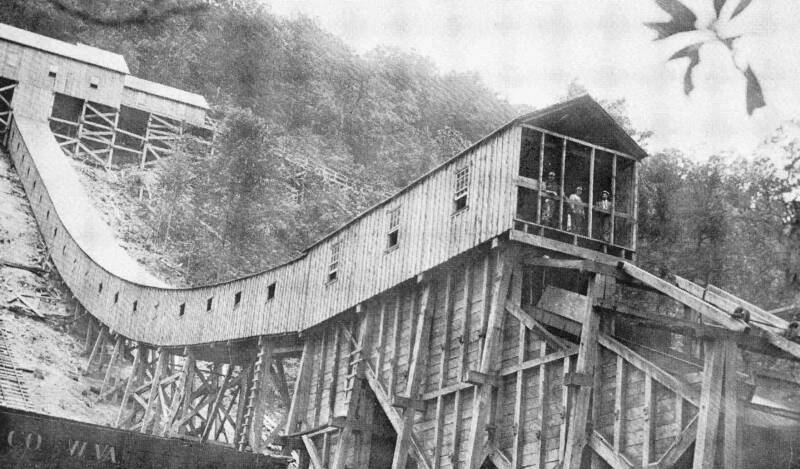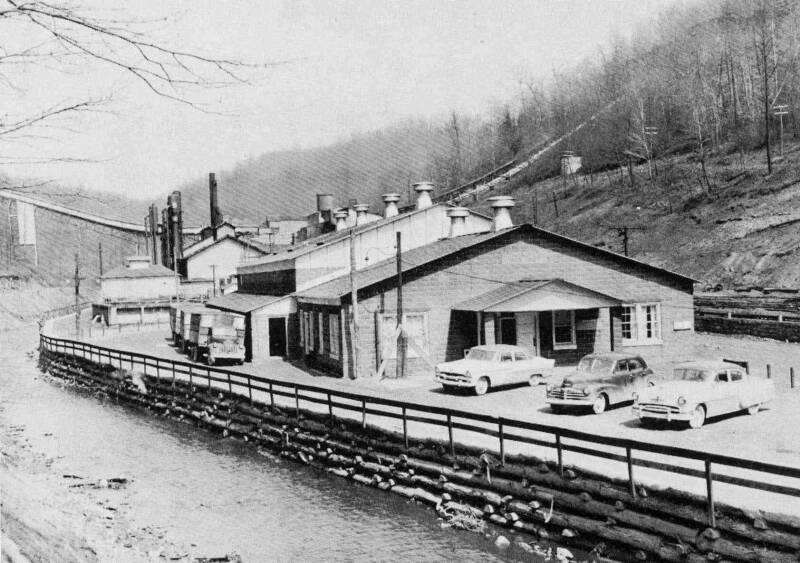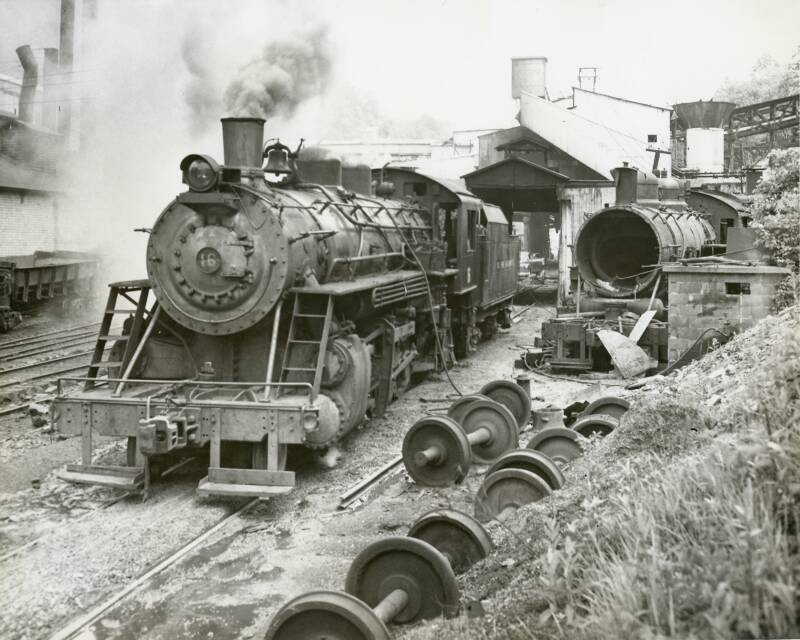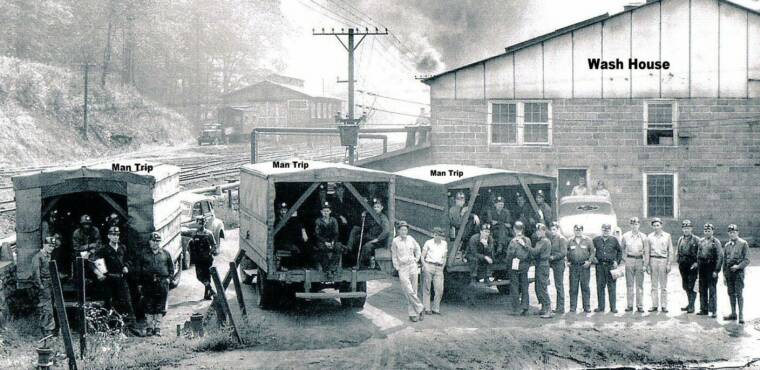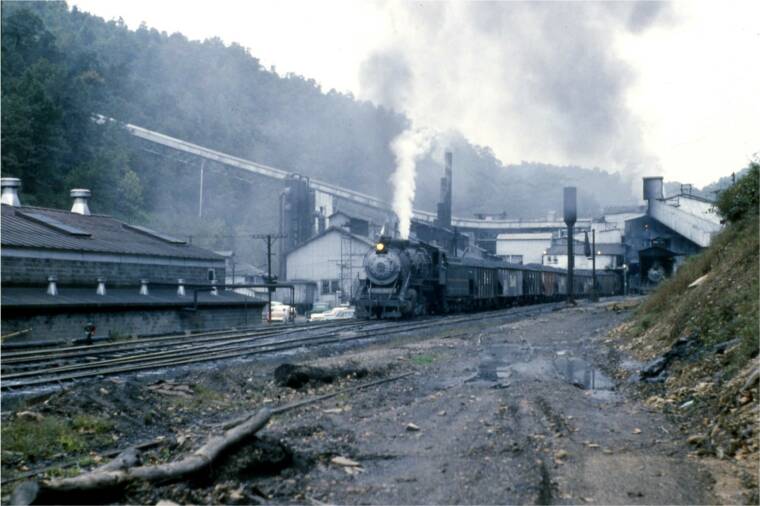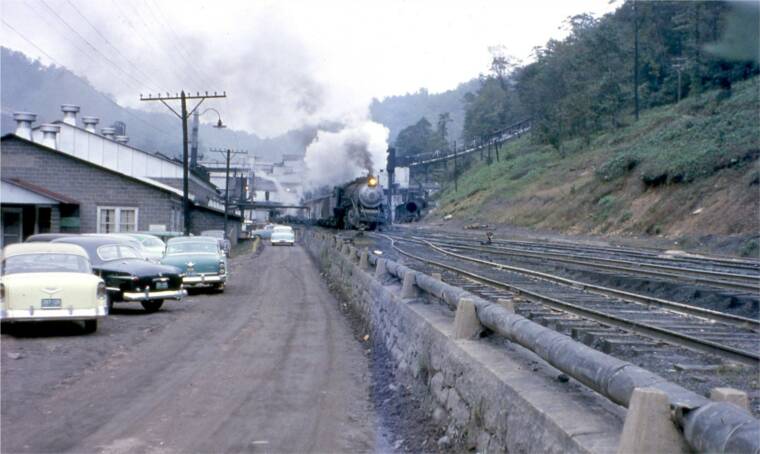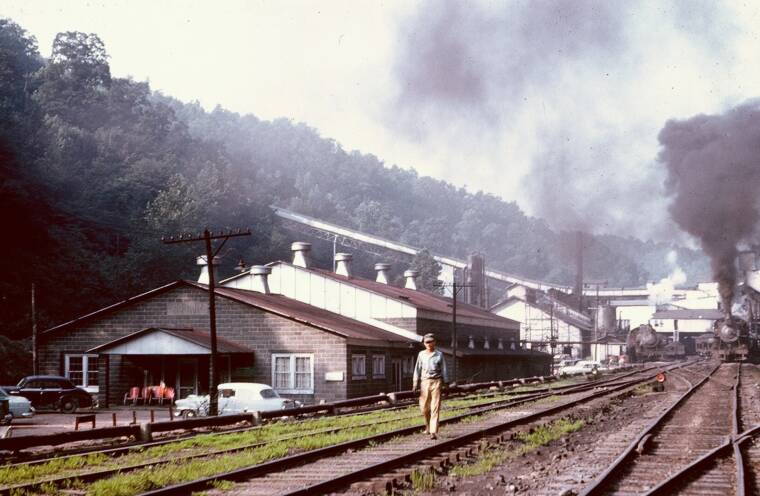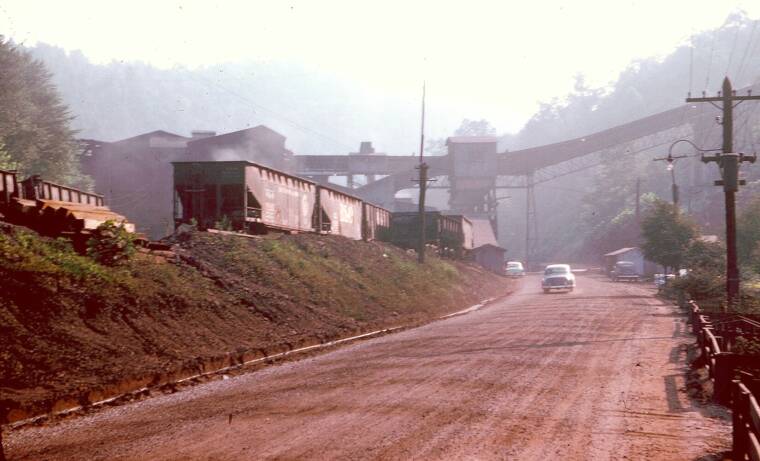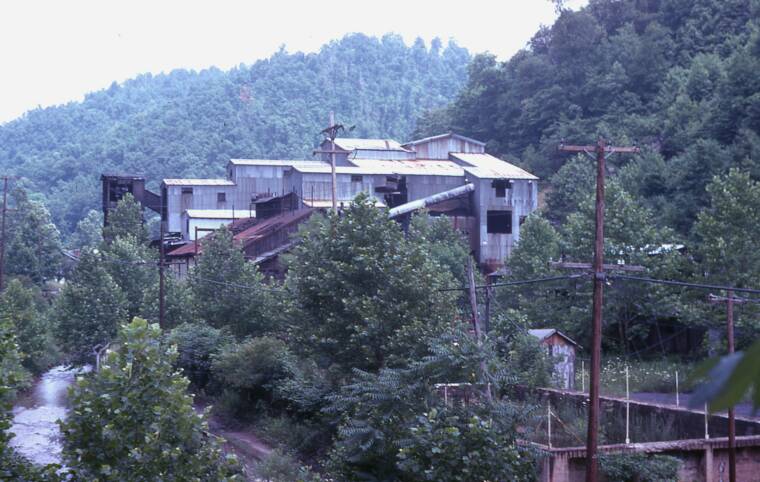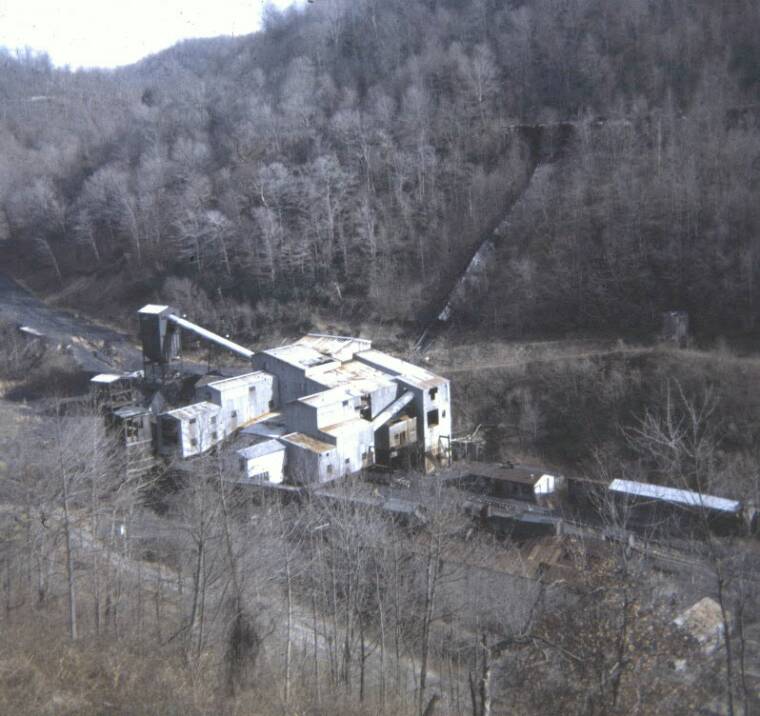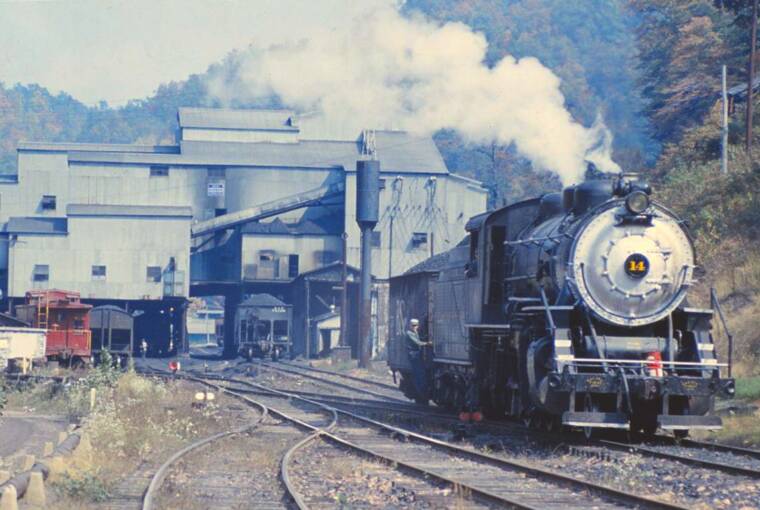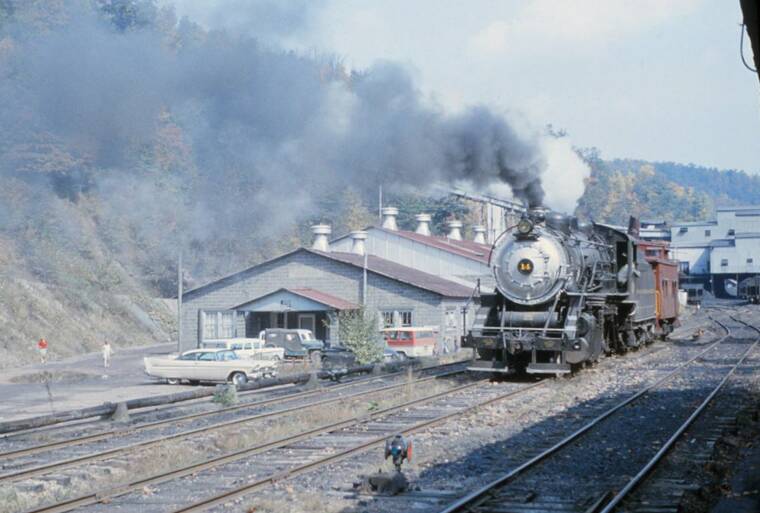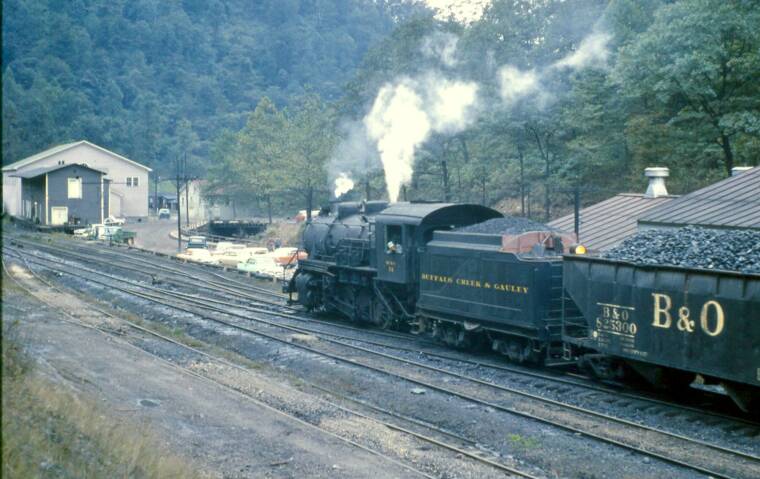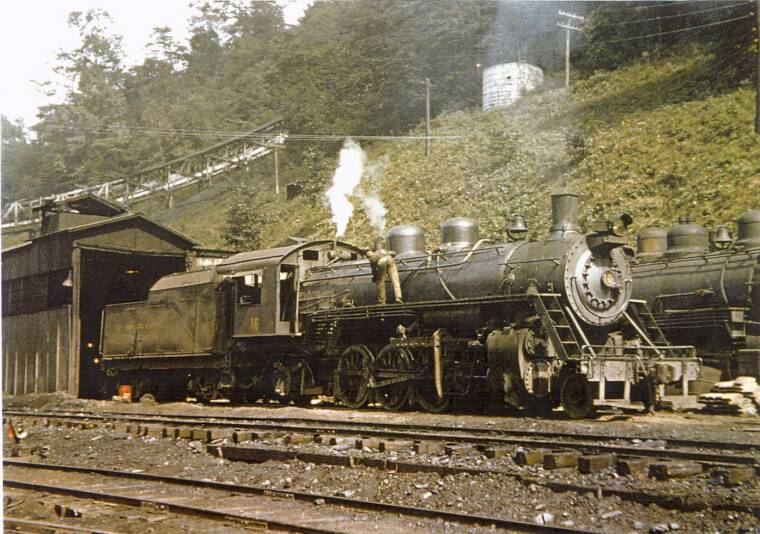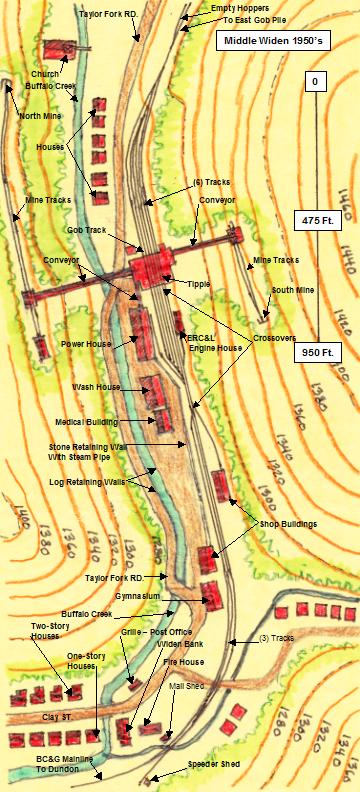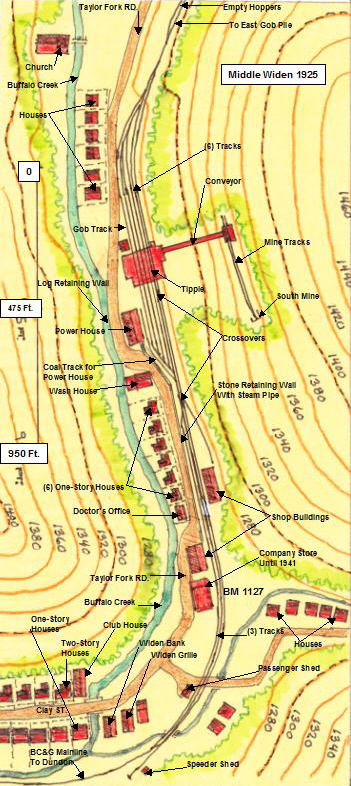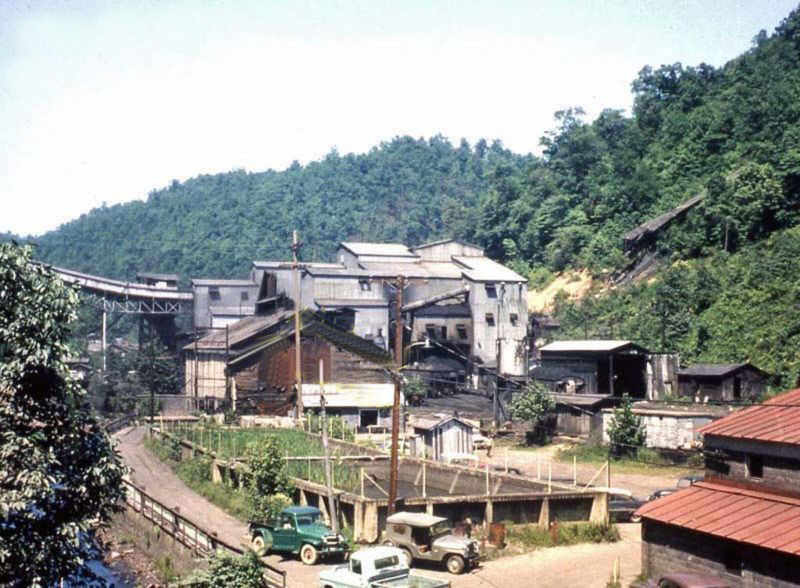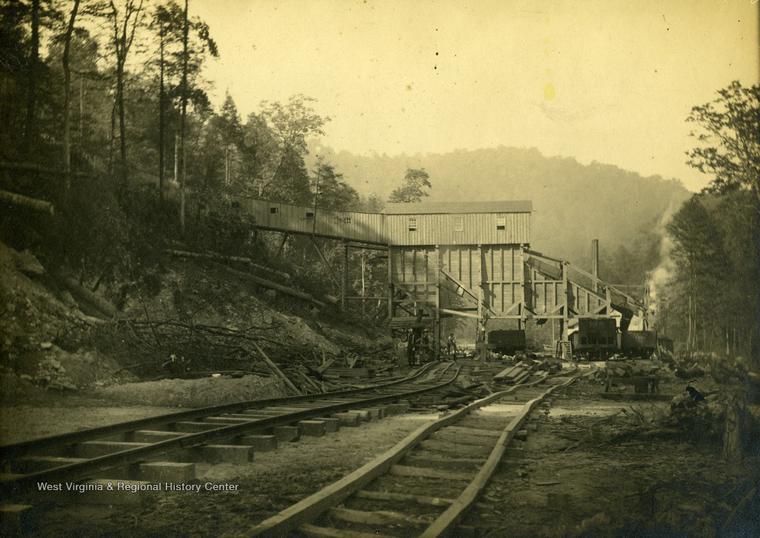Tipple
The most recognizable part of a mine is the tipple, the buildings in which the raw coal is sorted, cleaned and then loaded into hoppers. This series of photos shows the evolution of the tipple at the Rich Run Mine. What started as a relatively small wooden structure evolved into a much larger all-galvenized affair. From the first shipment on July 14, 1911 (Widen, An Appalachian Empire, Book 1) until December 30, 1963 the tipple at Widen produced DUNDON COAL, noted for its hard structure (would ship without breaking), low sulphur content and high fusing point of its ash (NHRS BULLETIN 3rd Qtr 1955).
These two sepia-tone photos (from the collection of Marie Spencer) show the tipple as it looked in its early years. It was of wood construction as was the conveyor up the hillside to the minehead. This conveyor went up the south side of the valley and was called the "South Mine". Mining took place on this side of the valley for about 30 years.
This is a wonderful photo because not only does the mine look almost brand new, but all those hoppers are BC&G hoppers!! Click the image for a larger view to see for yourself! They are among the 900 that the BC&G had in interchange service in the '20's. It's easy to orient the pitched roof structure (A) with 6 windows in this photo with the photo above and the one below left.
As I was selecting photographs for this page I hoped that I would be able to demonstrate the evolution of the tipple structure. I think of this photo as a "transition" picture...some of the original wood structure is evident but a major portion of the tipple is now metal, and the overall building is significantly bigger
A
A
A
This is the final configuration of the RICH RUN tipple. It's difficult to see any common elements with the "transition" photo above except the wooden tower-like structure at the far left (B). That structure also appears in three photos below. In one of them it appears this tower at one time had something to do with loading gob cars. By this time the conveyor goes up the mountain to the left...to the North Mine.
B
B
B
This is one of my favorite photos of activities at the mine. ERC&L #17 is taking on water before heading to the gob pile with a string of loaded side-dump hoppers. There were many buildings along the tracks leading to the tipple. These buildings are part of the power plant. The tipple is to the right and the conveyor to the North Mine is clearly visible. The gob tower (B) is visible as is the sanding tower (E) and the water plug (F). The cupola (G) of the powerhouse is visible in the photo below.
Dave Marquis photo - circa 1972
Dave Marquis photos -circa 1972
All good things must come to an end, unfortunately. And so it was with the RICH RUN mine on December 30, 1963. Consolidation #13 ran light with just a caboose from Dundon and returned with 103 cars from the mine. The simple ERC&L engine house is just visible on the right (C) (Also see photo below). A detail photo of the water tank (D) appears at the bottom of this page.
This is the only color photo I'm aware of that shows the backside of the tipple. Thanks, Dave, for these wonderful images! According to the Warden book, the tracks extended about 3000 feet on this side of the tipple and there was a large gob pile here, as large as the more familiar one west of the mine.
Russell Baum photo - circa 1955
C
E
F
This photograph is one of the few that shows that the ERC&L ubiquitous red was used on the mine structures as well as the residential structures. The photographer is standing about where the locomotive is in the photo on the left. The tipple was straight ahead. This building (H) is the second one on the left in black and white photo with the train (above left) and is also visible in the photo to the left. It looks like this simple wood structure survived from the 1920's till the 1980's!
This structure was used to repair electric motors, sharpen drills and general carpentry work.
This color photo shows the building (I) in the left foreground of Nelson's picture above. This was the Widen gymnasium.
Nelson Stover - 1981
Nelson Stover - 1981
I
H
H
From Sigman website, Charles Dodrill collection - circa 1925
I intentionally placed this image out of chronological order so it could be easily compared to the color image above. This is another circa 1925 image from Charles Dodrill collection. What's great about this photo is that it is from the backside of the tipple and suggests that tower (B) had something to do with loading the gob cars. It's amazing that the tower survived virtually unchanged from this photo till the mine closed in 1963, a period of almost 30 years!
While the shape of the tipple is dramatically different from the Marquis photo, it appears that there were 6 tracks under the tipple from the early days till the end. As mentioned earlier, these tracks extended over a half mile in this direction to a gob pile that probably predates the one west of Widen.
H
I
I
Collection of Max S. Robin
From Sigman website, Charles Dodrill collection - circa 1925
Sigman website, Charles Dodrill collection - circa 1925
B
WASHING COAL
I wasn't quite sure where to put this information but it seems to relate most directly to the tipple, so I'm putting it here. One of the processes that took place in the tipple was the washing of coal. According to an interview with a Mr. Benjamin Hamrick (date unknown), reported on page 88 of "WIDEN, An Appalachian Empire, Book 2 , in that process "the mined coal was cleaned in a "washer box" with water and magnatite. The gob went to the bottom, and coal floated. The dirty water was at one time dumped into the Buffalo Creek, but was later pumped over the hill into Taylors Fork". Needless to say, the Buffalo Creek, and probably Taylors Fork as well, was so filled with coal dust and contaminents that it was almost black in color and nothing could live in it. In fact, yet today you cannot eat fish from the Buffalo Creek downstream between the mine and the Elk River.
D
D
Here's another one of those great photographs taken by a modeler for modeler's! This neat little water tank, presumably for servicing locomotives, appears on the left in one of the photos above. It has a neat lower structure in overall would make a nice model on any layout.
Dave Marquis photos -circa 1972
Photos 1 and 2 are from the Warden BC&G book and are supposedly from 1912. That would certainly make them the first tipple built. These two pictures are also quite certainly of two different sides of the same structure.
Photo 3 on the left is from about 1925. It is almost certainly the same structure as the photos below. It does not appear, however, to be the same structure as the 1912 photos 1 and 2. The 1912 structure is very compact and looks to be simply a loading facility at the bottom of the conveyor. The 1925 structure, however, is a much more elaborate tipple.
The minehead in the 1925-era photo 4 looks like it could be an evolution of the minehead in the 1911 photo 2.
1
2
3
Two photos Bobby Caruthers collection
4
Moving further back from the tipple were these low buildings featuring vented roofs. These were the miners wash rooms and medical building (nearest the camera). The nearest structure possibly included a union meeting room in the later years.
The cupola building from the photo above is clearly visible in the background (G) in this 1958 photo.
Note that the conveyors to both the old South Mine and the North Mine, in service at this time, are clearly visible.
G
G
John Killoran - April, 1958
B
Richard Manning Collection - 1959
I've included this photo simply because I think it captures so vividly what the area around the Rich Run Mine looked like. In this view looking into the small engine house for servicing the ERC&L Mikados, there are more scrap parts that ones in use, it would appear. I particularly like the unidentified locomotive with no boiler front. In fact, it looks like the boiler is devoid of flues. And there are almost enough wheel sets in view to equip a complete gob car. And as far as the track is concerned, it looks like each passing engine clears its own flangeways in the dirt. Such is the way of the short line!
Structures near Tipple
H
Steam Condenser Towers
Of particular note are the three towers marked "H" in the Russell Baum photo above. Thanks to Mr. Peter Silitch, these towers have been identified by a former ERC&L employee as condensor towers for the steam power plant at the mine. In order to conserve water, especially during seasons when the water level in the creek was low, these towers condensed the expended steam from the turbines back into water to be recycled through the boilers again. Peter further explained that the turbines made a whining sound that could be heard continuously while the mine was in operation and that the power plant provided electricity for the areas well beyond the mine itself.
Other Structures
On the right in this photo is the miners wash house. This is the opposite end from the end seen in the Killoran photo above. It is assumed that the miners rode to the tipple in the trucks, although any information on this would be appreciated.
Of interest is the view of the building in the distance. It appears that this is the building on the right in Photo 3 near the top of this page. A logging-type caboose is visible sitting on the track that enters the building suggesting that this must have been a railway equipment maintenance building.
Loretta Samples collection
According to Loretta Samples, whose father worked at the mine for many years, there was a road that went to the headhouse. The men met at the wash house by the tipple and were transported by trucks (man trips - see photo below). They could also walk or take a car up the hill to the headhouse.
From the collection of Theodore Griffith
Theodore Griffith provided this unique high angle photo of the Widen mine sometime before 1939 when the South Mine was closed and operation moved to the opposite side of the valley. The conveyor (yellow arrow) moved coal to the powerhouse that provided power for all of Widen until around 1940.
John Phillips - Two photos 10-2-58
John Phillips took this great overview of the tipple area complete with #14 assembling a train of loads on a rainy, overcast October day. The photo shows the long conveyor to the north mine very clearly. An engine is poking its nose out of the engine house on the right.
The photo to the left, taken at the same time as the one above has #14 getting underway with the string of hoppers. It is assumed that the pipe in the foreground (maybe wrapped in asbestos!) carries steam for heat to other buildings. Nice work, John!
This nice crisp color photo was taken by Roland Coluzzi sometime in 1959 or 1960. It shows the wash room building and medical building from the 'track side' and their actual colors are evident. The gob engines are, as usual, smoking things up!
Part of the adventure of building this website has been the discovery of unique photos, such as this one, taken by Roland Coluzzi, circa 1959, and sent to me by his son, Roland Coluzzi, Jr. It is the only photo I've ever seen from this vantage point behind the tipple. The tower (B) in the center of the picture appears to be the same one in the much earlier photo above. The conveyor to the North Mine goes off to the right. Notice the fences along the street suggesting there are houses here. Notice, too, the Clark side-dump gons in among the regular hoppers.
B
Richard Bradley took the photo above in July 1969. The photo on the right was taken by Theodore Griffith in late fall of 1970. Theodore's photo shows the tower (B) that was built by Clinchfield around 1960 when they began using Euclid trucks to haul strip mined coal to the tipple and emptied the trucks at a load-out at that spot. The tower was part of the system for getting truck-transported coal through the tipple. The haul road from the strip mine is just visible to the left of the tower. The tower is not visible in Bradley's photo due to the angle from which it was taken.
A
B
A
Both photos show the entirety of the tipple in the years after it was closed. WIth the photos on this page an exact model of the Rich Run Mine could be constructed by the willing modeler!
According to Ovalee Gill, gob engineer, the coal went through a washer to separate the coal, which floated, from the gob which sank. Men called "slate picks" picked out the larger rock and slate that wouldn't go through the sorter.
Doug Wingfield captured #14 at work again a couple of years later. These two images are dated October 1962. Again, the locomotive appears to be in impeccable condition. Even the mine and support buildings all appear well maintained.
John Phillips Photo taken October 1958
John Phillips captured #14 at Widen from an unusual vantage point up on the hillside. Builidngs H (machine repair) and I (gymnasium) are visible down the track in front of the engine which has been turned on the wye and is headed toward Dundon.
Notice how full the ubiquitos B&O hopper is!
H
I
This nice clean photo is undated and the photographer is not known, but it shows a clear view of one end of the small Widen engine house. It looks like maybe #16 is being prepared for painting. Based on the shape of the steam domes, the engine behind is the same one visible in the photo above with the boiler front removed.
Also visible is a tank on the hillside that presumably provided the pressure head for the water plugs.
Detailed maps of the area around the tipple prepared by Phil Bonzon are at the bottom of this page.
Maps of Middle Widen
These two beautiful maps of middle Widen in 1925 (left) and 1950 (right) were prepared by Phil Bonzon. They are based on photographs and individual accounts and are drawn over US Geological survey maps. These drawings represent the most complete representation of the details of the track and structures around the tipple ever compiled, we believe. For maps of the entire area of WIden CLICK HERE.
Phil Bonzon
Phil Bonzon
For photos and maps of the area beyond the tipple, CLICK HERE.
This photo by an unknown photographer is dated 1963, and given that it appears to have been taken in the summer months, it must have been just months before the mine was finally closed. There are loaded hoppers under the tipple but no locomotives are in view. Notice that the wooden conveyor to the original South Mine is almost completely collapsed.
Just when I think I've come across all the available information and photos, something new surfaces! Thanks to Nick Fisher for providing a link to this 'earliest yet' photo of the Rich Run Mine. The very light rail on ties on the ground (left) and wooden rail (right) suggest this image pre-dates the images below from the Warden book. This picture is from www.wvhistoryonview.org.
(11/3/2021)
11/3/2021
